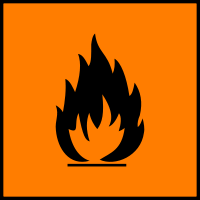|
Storage Warning
|
|
Highly Flammable/Corrosive/Harmful/Moisture Sensitive/Store under Argon/Keep Cold
|
 Show
data source Show
data source
|
|
Moisture Sensitive
|
 Show
data source Show
data source
|
|
|
RTECS
|
|
VV2710000
|
 Show
data source Show
data source
|
|
|
European Hazard Symbols
|
 Corrosive (C) Corrosive (C)
|
 Show
data source Show
data source
|
|
Corrosive (C)
|
 Show
data source Show
data source
|
 Flammable (F) Flammable (F)
|
 Show
data source Show
data source
|
|
Flammable (F)
|
 Show
data source Show
data source
|
|
X
|
 Show
data source Show
data source
|
 Harmful (Xn) Harmful (Xn)
|
 Show
data source Show
data source
|
|
|
UN Number
|
|
1298
|
 Show
data source Show
data source
|
|
1993
|
 Show
data source Show
data source
|
|
2920
|
 Show
data source Show
data source
|
|
2924
|
 Show
data source Show
data source
|
|
UN1298
|
 Show
data source Show
data source
|
|
|
MSDS Link
|
|
|
German water hazard class
|
|
1
|
 Show
data source Show
data source
|
|
2
|
 Show
data source Show
data source
|
|
|
Hazard Class
|
|
3
|
 Show
data source Show
data source
|
|
8
|
 Show
data source Show
data source
|
|
|
Packing Group
|
|
2
|
 Show
data source Show
data source
|
|
II
|
 Show
data source Show
data source
|
|
|
Risk Statements
|
|
10-14-34-40
|
 Show
data source Show
data source
|
|
11-14-19-35-37
|
 Show
data source Show
data source
|
|
11-14-20/21-35-37
|
 Show
data source Show
data source
|
|
11-14-21-34
|
 Show
data source Show
data source
|
|
11-20/21-36/38
|
 Show
data source Show
data source
|
|
R11, R14, R20, R21, R35, R37
|
 Show
data source Show
data source
|
|
|
Safety Statements
|
|
16-26-36/37
|
 Show
data source Show
data source
|
|
16-26-36/37/39-45
|
 Show
data source Show
data source
|
|
26-36/37/39-45
|
 Show
data source Show
data source
|
|
7/9-16-26-36/37/39-45
|
 Show
data source Show
data source
|
|
8-16-26-30-36/37/39-45-60
|
 Show
data source Show
data source
|
|
S16, S26, S36, S37, S39, S45
|
 Show
data source Show
data source
|
|
|
TSCA Listed
|
|
是
|
 Show
data source Show
data source
|
|
|
GHS Pictograms
|

|
 Show
data source Show
data source
|

|
 Show
data source Show
data source
|

|
 Show
data source Show
data source
|

|
 Show
data source Show
data source
|

|
 Show
data source Show
data source
|
|
|
GHS Signal Word
|
|
Danger
|
 Show
data source Show
data source
|
|
|
NFPA704
|
|
|
 Show
data source Show
data source
|
|
|
Explode Limits
|
|
6.4 %
|
 Show
data source Show
data source
|
|
|
GHS Hazard statements
|
|
H225-H311-H314-H318
|
 Show
data source Show
data source
|
|
H225-H312-H314-H331-H335
|
 Show
data source Show
data source
|
|
H225-H312-H315-H318-H332
|
 Show
data source Show
data source
|
|
H225-H314-H335
|
 Show
data source Show
data source
|
|
H226-H314-H351
|
 Show
data source Show
data source
|
|
|
GHS Precautionary statements
|
|
P210-P261-P280-P305 + P351 + P338-P310
|
 Show
data source Show
data source
|
|
P210-P280-P305 + P351 + P338
|
 Show
data source Show
data source
|
|
P210-P303+P361+P353-P305+P351+P338-P361-P405-P501A
|
 Show
data source Show
data source
|
|
P280-P305 + P351 + P338-P310
|
 Show
data source Show
data source
|
|
|
Personal Protective Equipment
|
|
Faceshields, full-face respirator (US), Gloves, Goggles, multi-purpose combination respirator cartridge (US)
|
 Show
data source Show
data source
|
|
Faceshields, full-face respirator (US), Gloves, Goggles, multi-purpose combination respirator cartridge (US), type ABEK (EN14387) respirator filter
|
 Show
data source Show
data source
|
|
|
RID/ADR
|
|
UN 1298 3/PG 2
|
 Show
data source Show
data source
|
|
UN 1993 3/PG 2
|
 Show
data source Show
data source
|
|
UN 2920 8/PG 2
|
 Show
data source Show
data source
|
|
UN 2924 3/PG 2
|
 Show
data source Show
data source
|
|
|
Supplemental Hazard Statements
|
|
May form explosive peroxides., Reacts violently with water.
|
 Show
data source Show
data source
|
|
Reacts violently with water.
|
 Show
data source Show
data source
|
|